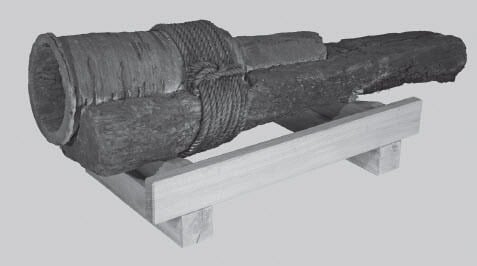
A rare shipboard cannon, discovered beneath the sea near Sweden, could be the oldest ship gun in Europe. Inside this remarkable find, scientists discovered bits of cloth, believed to be leftovers from a gunpowder bag called a cartouche.
Radiocarbon dating suggests that these cloth pieces date back to the 14th century. This makes the cannon one of the earliest of its kind, possibly the oldest ship gun ever found in Europe. Furthermore, the examination indicated that this weapon was loaded and set for action, not merely in transit for use on land.
Early cannons
The early cannon, unlike those shooting metal cannonballs, had a different purpose. Staffan von Arbin, a doctoral student in maritime archaeology at the University of Gothenburg in Sweden and the lead author of the study explained that these early cannons were designed to launch balls made of rock at attackers.
“This type of early cannon most definitely fired stone shots,” von Arbin stated in an email to Live Science. “The intention was not to sink an enemy vessel. These guns were ‘anti-personnel’ weapons — they were simply used to ‘clear the deck’ of an enemy vessel.”
The researchers who conducted this study, which was published in the journal The Mariner’s Mirror, aren’t sure whether the early cannon was installed on a merchant ship or a warship. However, they have plans to uncover this mystery by investigating the underwater site where the cannon was found.
Details of the cannon discovered
The cannon was located beneath the water at a depth of approximately 60 feet (about 20 meters) and approximately 3 miles (around 5 kilometers) southwest of Marstrand Island on Sweden’s western coast.
The archaeologists propose that the cannon may have originated from a ship that sank at this location, possibly after hitting a low rock known as Kleningen, situated a few hundred feet to the south. However, they also acknowledge the possibility that it could have been accidentally dropped or thrown overboard from a distressed ship.
This cannon has a unique shape, measuring nearly 19 inches (about 47.5 centimeters) in length and resembling a funnel.
It has a narrow chamber at the back for holding gunpowder and a broad barrel that measures over 7 inches (approximately 18.5 cm) in width at the front. Some cannons of this type were equipped with a wooden gun carriage to facilitate aiming.
According to von Arbin, these funnel-shaped cannons were among the earliest types used in Europe after the technology arrived in the 13th century, likely introduced from the Middle East. The precise reason for their distinct shape remains uncertain, but it may have been related to how they were loaded.
Metal composition of the cannon
The scientists also scrutinized the cannon’s metal composition using a method called inductively coupled plasma mass spectrometry (ICP-MS). This technique involves turning a small sample of the material into a gas by subjecting it to high-temperature plasma and then analyzing it.
Initially, they expected the cannon to be constructed from gunmetal, which is a type of bronze made by blending copper and tin, with added zinc and nickel for extra durability.
However, their analysis revealed that it was actually made from a copper alloy with relatively low amounts of tin and high levels of lead, which would have made it somewhat fragile.
Stone shots were brought onto the ship in a rough state and worked to fit the barrel of the cannon it would be fired from?
They were mostly Kentish ragstone, a hard limestone. Some cannonballs still show the marks from where they had been worked! pic.twitter.com/jAw4UmJ4LH
— The Mary Rose (@MaryRoseMuseum) August 25, 2020
The researchers observed that this alloy wasn’t suitable for making cannons and suspected it was used because better alloys were not known during that period.
Von Arbin pointed out that during the 14th century, the Baltic Sea was bustling with trade ships, and merchant vessels often carried weapons to defend against pirates and enemy ships.
Location of the discovery
The location where the ancient cannon was discovered is exposed, and any shipwreck there has likely disintegrated. Nevertheless, von Arbin is hopeful that an examination of the seafloor might reveal some remnants of the cannon.
Additionally, further analysis using dendrochronology, a technique that examines tree growth rings in wood to determine their age and origin, could potentially unveil more information about the ship’s history and when it sailed.
See all the latest news from Greece and the world at Greekreporter.com. Contact our newsroom to report an update or send your story, photos and videos. Follow GR on Google News and subscribe here to our daily email!



